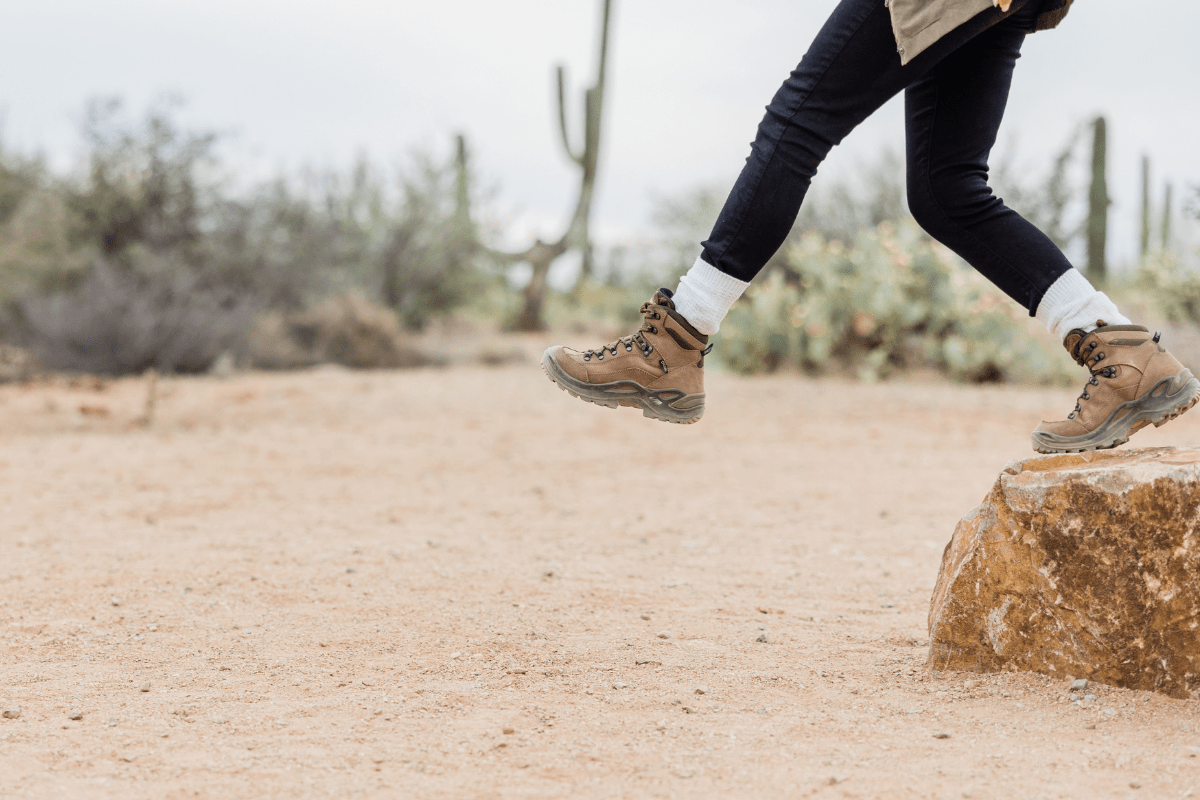Phoenix is paradise for hikers, offering everything from quick urban getaways to rugged summit climbs and all-day desert adventures. Whether you’re seeking sunrise city views or quiet cactus-lined trails, the area surrounds you with beautiful options for every skill level.
Let’s get to it.
Piestewa Peak Trailhead
At first glance, Piestewa Peak Trailhead does not feel like a gentle stroll. The Summit Trail is a 2.4-mile out-and-back route with about 1,200 feet of elevation gain. It’s steep, rocky, and involves some scrambling, so you won’t look fresh for brunch afterward.
On the plus side, you get sweeping views of the Phoenix skyline on one side and the Sonoran Desert plus distant mountain ranges on the other. Expect company along the way—parking fills quickly during sunrise and sunset hours. Dogs are not allowed on the Summit Trail, so leave your pet at home.
Facilities at the trailhead include restrooms, drinking water, and a couple of shaded ramadas. Beyond that, it’s just you, the cacti, and a long string of stone steps. Avoid summer afternoons if you hate baking. The trail remains open until 11 p.m., offering cooler-hour options. Just bring sturdy shoes and your best leg game, and don’t count on being alone.
North Mountain – Trail 44
North Mountain Trail 44 packs an ambitious climb into 1.4 miles each way. The path consists of natural dirt, loose gravel, and rocky steps, with grades averaging 16 percent and peaking near 27 percent on short pitches. Several sections require a brief scramble with both hands free for balance.
As you climb the narrow switchbacks, you will gain sweeping views of saguaro-covered slopes and the Phoenix skyline. A bench at the summit offers a spot to rest and enjoy the view. Hikers may also encounter wildflower blooms in spring or mule deer grazing near rocky outcrops.
The trailhead sits at North Mountain Park Visitor Center, where free parking, vault restrooms, and shaded picnic tables are available. Dogs on leash are welcome. Most hikers complete the round trip in one to one-and-a-half hours, depending on pace. The trail rarely feels crowded except at sunrise or on weekend mornings. Hiking between October and May avoids intense summer heat and makes for a more comfortable experience.
Camelback Hike
Camelback Mountain dominates the Phoenix skyline and offers two main hiking routes to its summit. Echo Canyon Trail is a steep 1.2-mile climb with handrails and chains to help navigate exposed sandstone ledges. Hikers encounter narrow steps and sections requiring hand-over-hand pulls. Cholla Trail stretches just over 1.5 miles one-way and gains about 1,200 feet through switchbacks that ease the ascent. Both routes require sturdy shoes and a good level of fitness.
For a gentler outing, Bobby’s Rock Loop and Ramada Loop stay near the mountain’s base. These shorter trails range from one to two miles over flatter ground and serve as warm-ups or cooldowns.
Echo Canyon trailhead includes restrooms, shade ramadas, and water stations at the trailhead only. Parking is limited and often fills before 8 am in cooler months. No pets are allowed on any routes. Trail runners, hikers, and climbers share narrow paths, so expect to yield on steep sections. Early morning starts between October and April help avoid extreme heat.
Desert Vista Trailhead
Desert Vista Trailhead marks the main entrance to the Sonoran Desert Preserve north of Phoenix. A spacious dirt-and-rock parking lot meets you first, complete with clear trail maps and restroom facilities. From here you can choose from multiple routes: the Bobcat Trail offers a flat, beginner-friendly loop while the Dixie Mountain Summit Trail climbs over 2,000 feet in under two miles. Other options include Cactus Wren, Western Vista, and Union Peak, each signed at junctions and ranging from mild to strenuous.
Landscapes shift from saguaro and cholla cactus to clusters of palo verde and ocotillo. Most trails have minimal shade, so start early and carry at least two liters of water. Weekday mornings tend to be quiet and you might see leashed dogs alongside local hikers. Wheelchairs and strollers are not advised on these rugged, uneven surfaces.
Plan on two to four hours for most routes, depending on distance and elevation. Desert Vista Trailhead is popular but rarely crowded before 9 am. Cooler months of October through April provide the most comfortable conditions.
Javelina Canyon Trailhead
At Javelina Canyon Trailhead, the parking lot buzzes with hikers and bikers on weekend mornings. This free lot serves the start of several singletrack paths that wind through rolling hills and rocky sections. The 1.7-mile one-way main trail stays mostly gentle with occasional streambeds to hop and loose gravel underfoot. Casual hikers can enjoy desert scenery, while those seeking a longer route can connect to Ridgeline, Mormon Loop, or National Trail for added mileage.
Saguaros dot the landscape and you may spot spring wildflowers along canyon walls. City vistas peek through openings as the trail climbs slightly toward the ridgeline. Watch for horses, mountain bikers, and fellow hikers on shared-use sections, especially around blind corners. Signposts appear at key junctions but carry a map or GPS just in case.
Leashed dogs are welcome, and rattlesnake warnings make water and sturdy shoes essential. Restrooms and picnic tables sit near the parking area, but there is no shade on the trail. Hiking between October and May offers cooler temperatures.
Corona de Loma Trail
Corona de Loma Trail is a 6.4-mile out-and-back that challenges you from the first rocky switchback. You will climb 1,305 feet of elevation gain along narrow singletrack that weaves through loose stones and exposed desert slopes. The path offers no shade… afternoon sun bakes the trail. Street parking is available at the trailhead and there are no restrooms or benches on the route, so plan accordingly.
Most hikers finish the round trip in three to four hours, though loose rocks can slow you down. Watch for lizards and other desert wildlife as you climb.
Views are the reward. From Buena Vista Lookout you can see the Phoenix skyline and surrounding mountains. The trail features saguaro cactus groves and wildflower blooms in spring. Leashed dogs are welcome, though some hikers let pets roam loose. Expect to share the route with runners, hikers, and mountain bikers and step aside on tight turns. Trails are well marked by Phoenix Parks & Recreation. For cooler conditions, hike between September and June.
Desert Foothills Trailhead
Found at the edge of South Mountain Park, Desert Foothills Trailhead links to the popular Telegraph Pass Trail. The first half mile features textured concrete, so you’ll see strollers and parents testing both their kids and their coffee. Beyond that, the path transitions to loose rock and gravel, demanding sturdy footwear.
The out-and-back route spans just over two miles with nearly 500 feet of elevation gain. You’ll pass desert wildflowers in season and desert wildlife like lizards or ground squirrels. At the top, an overlook reveals a sweeping view of Phoenix below.
The trailhead provides paved parking, restrooms, and shade structures. It stays busy from October through May, so early starts are best. No wheelchairs beyond the concrete section, and leashed dogs are welcome if they can handle the rocky surface. Regular city maintenance keeps signage clear and facilities in good shape year-round.
Mormon Trailhead
Serving as the gateway to South Mountain Park, Mormon Trailhead sits just south of downtown Phoenix. The paved lot holds about 30 cars, with street parking as overflow. Arrive early or midweek to avoid circling for a spot. Signage from the parking area clearly points to several trails.
Hidden Valley Trail is a moderate loop featuring a natural tunnel, slot-canyon sections, and a narrow squeeze called Fat Man’s Pass. The main Mormon Trail climbs steeply past petroglyph sites, while the Mormon Loop offers extended desert and city views. For a longer challenge, the National Trail continues with over 1,000 feet of elevation gain.
Leashed dogs are welcome on all paths. The surface is dusty and strewn with rocky chunks, giving it classic Arizona character. Trails may close in extreme heat from May through September. From October to April, the paths fill with hikers enjoying cooler temperatures and well-maintained routes.
Pima Canyon Trailhead
Tucked near South Mountain Park, Pima Canyon Trailhead offers a reliable desert escape. The free parking lot holds about 50 cars, but spaces vanish quickly on a busy weekend morning. Facilities include flush restrooms, drinking fountains, trash cans, and dog waste bag dispensers. Trail maps and heat-warning signs are posted at the kiosk.
Trail options range from the 1.2-mile Dirt Road Trail to the nine-mile Desert Classic. Both feature rocky terrain and minimal shade. A family-friendly loop combines Pima Wash and Ridgeline Trail for a shorter outing. Petroglyphs appear along the longer routes, offering a glimpse of local history.
Leashed dogs can join provided temperatures stay moderate. The trail surface is dirt and gravel, not stroller-friendly. Watch for loose stones and the occasional snake sunning itself on a rock. Cell service is spotty, so carry water and a printed map. Overall, this trailhead balances convenience with true desert hiking conditions.
Phoenix Mountains Preserve
Hidden in plain sight, Phoenix Mountains Preserve offers over 200 miles of desert trails covering every skill level. Short loops like Nature Trail #304 span under a mile, ideal for a quick leg stretch. If you want a challenge, head to Piestewa Peak—1.2 miles on paper but feel like a stair-climbing test. Mid-length loops and point-to-point routes fill out the rest of the network.
Trails follow natural desert terrain, with rocky dirt, switchbacks, stone steps, and cactus lining the path. You might spot javelina or coyotes early in the morning or at dusk. Leashed dogs are welcome on all trails except the Summit Trail at Piestewa Peak. Parking is free, and drinking fountains are available at the main trailheads.
This area gets crowded around dawn and dusk, so starting early or late helps you avoid the busiest stretches. Summer heat can be intense, so most hikers stick to fall through spring. The city maintains clear signage and regular trail upkeep, keeping paths in good condition year-round.
Bursera Trailhead
Located in South Mountain Park, Bursera Trailhead features a 3.3-mile loop with 750 feet of elevation gain. The path includes switchbacks and loose gravel but no technical scrambling. Trail markers guide you from start to finish, and City of Phoenix crews keep the route in good shape…though heavy rain can create small washouts.
Views span the Valley, the Estrella Mountains, and surrounding desert. Wildflowers bloom in spring, and javelina or bobcat sightings are possible. There are no restrooms, water stations, or shade structures along the exposed ridge. Carry ample water for yourself and any leashed dog.
Parking can fill quickly, so aim for an early start between October and May when temperatures are cooler. This trail offers a solid leg workout without demanding technical skills, making it a dependable choice for hikers seeking desert panoramas with manageable challenge.
Sonoran Preserve -Desert Vista Trailhead
Sonoran Preserve’s Desert Vista Trailhead offers a versatile network of trails amid prickly pear cactus. You can choose from a series of loops and out-and-back routes, most clearly marked and easy to follow even though the surroundings are rugged desert hills. Trails range from the gentle Bobcat Trail to the challenging Dixie Mountain Summit, which features nearly 700 feet of elevation gain. Shorter routes provide a more relaxed hike and allow you to take in views of Union Peak before breakfast.
The scenery includes rolling desert hills, seasonal wildflowers, and sweeping 360-degree panoramas. On clear days you can see landmarks like Camelback Mountain and Shaw Butte in the distance. Wildlife such as coyotes and quail appear along the way, and occasional rattlesnakes may cross your path, so remain alert. Facilities include a generous parking lot, restrooms, water fountains, and shaded benches. Dogs are welcome on leash and must avoid cholla cactus. The trailhead can get busy on winter mornings yet still feels less crowded than many nearby sites. Trails stay in good condition thanks to City of Phoenix maintenance, though sandy washes are not suitable for strollers.





